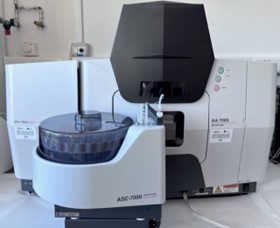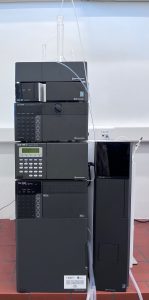Chromatography and spectroscopy
Chromatographic and spectroscopic analytical methods:
- Gas chromatography (GC-MS) and Gas chromatography with thermal conductivity detector (GC-TCD),
- Liquid chromatography (HPLC),
- Ion chromatography (IC),
- Inductively coupled plasma optical emission spectrometry (ICP-OES),
- Inductively coupled plasma mass spectrometry (ICP-MS),
- Ultraviolet spectrophotometry UV-1900i (UV-VIS)
- Atomic Absorption Spectroscopy AA-7000 (AAS).
Equipment
GC-MS, GCMS-QP2020 NX (Shimadzu) and GC-TCD, GC-TCD Nexis GC-2030 (Shimadzu)
Gas chromatography-mass spectrometry (GC-MS) enables the analysis of various samples. The column separates the sample into its various components, which are eluted from the column after a certain time.
The Shimadzu GCMS-QP2020 NX gas chromatograph is equipped with a mass selective detector (MS) and a flame ionization detector (FID). Samples can be introduced into the gas chromatograph via the headspace (HS) technique, liquid sample injection, and solid phase microextraction (SPME). The instrument is equipped with an autosampler that has the capacity to analyse 162 liquid samples and 45 gaseous samples. The Shimadzu GCMS-QP2020 NX has two split/splitless injectors, one for the MS and the other for the FID system, thus enabling the simultaneous installation of two chromatographic columns.
The GC-MS is widely used in environmental monitoring (to determine contaminants in air, water, and soil), in the oil and gas industry, and in the pharmaceutical industry. The analysis of esters, fatty acids, alcohols, aldehydes, terpenes, etc., in food, beverages, and fragrances is also performed with the GC-MS.
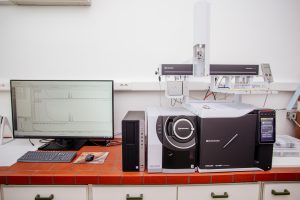
There is also the option of using the gas chromatograph with a thermal conductivity detector (GC-TCD) and an autosampler. TCD senses changes in the thermal conductivity of the eluting sample with regard to mobile phase. The autosampler allows a minimum sample injection volume of 0,2 µL and a maximum sample injection volume of 10,0 µL. The GC has built-in electronic control of the flow rates and pressures of all connected gases and includes a carrier gas-saving function.
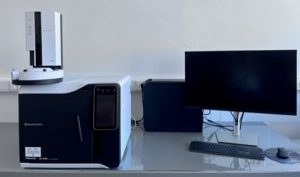
HPLC
A high-performance liquid chromatography (HPLC) system is suitable for the separation, identification, and quantification of very different analytes in liquid mixtures. Analytes are separated by injecting a liquid sample into a stream of solvent (the mobile phase) flowing through a column packed with a separation medium (the stationary phase). As they flow through the column, analytes in the sample separate from one another and elute at different times.
The relevant applications of the HPLC system include environmental, pharmaceutical, and clinical applications, applications in forensics, and applications in food analysis.
IC, HIC-ESP (Shimadzu)
Ion chromatography (IC) is used to detect anions and cations in environmental, medical, chemical, and food samples. A wide range of ions, charged molecules, including proteins, amino acids, and small nucleotides, can be separated based on their respective charged groups as they form electrostatic interactions with oppositely charged functional groups in the stationary phase.
IC consists of an autosampler, a column oven, a solvent delivery pump, an anion suppressor unit, a degassing unit, and a detector. The use of an autosampler allows high-speed injections, while an inert-type pump system optimizes the control of solvent delivery. An anion suppressor reduces the background signal from the eluent.
ICP-OES, Varian 710-ES ICP (Varian)
An inductively coupled plasma optical emission spectrometry (ICP-OES) can be used for the simultaneous analysis of elements in a wide range of samples. During analysis, atoms and ions absorb energy to move electrons from the ground state to an excited state. The source of that energy is heat from argon plasma operating at approximately 10,000 K. Those excited atoms and ions then release light at a specific wavelength as they transition to a lower energy state. The intensity of the light released at each wavelength is proportional to the number of atoms or ions making the transition. ICP-OES enables the rapid and simultaneous multi-elemental analysis of solutions.
Light in ICP-OES instruments is typically detected using a charged coupled device (CCD) detector. The CCD detector and optimized optical design provide excellent signal-to-noise performance, resulting in low detection limits. The Varian 710-ES instrument is equipped with an autosampler that has the capacity to analyse 180 samples. The key applications of ICP-OES concern food safety, soil analysis, drinking water quality and safety, and pharmaceutical analysis.
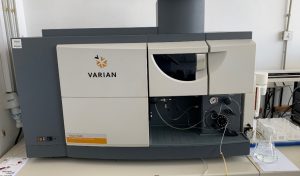
ICP-MS, ICPMS-2030 (Shimadzu)
An inductively coupled plasma mass spectrometry (ICP-MS) is a mass analyser that uses an inductively coupled plasma ion source to ionize atomic elements and produce ions that are separated based on their mass-to-charge ratio. It is useful for the quantitative and qualitative elemental analysis of various environmental, pharmaceutical, food, and other liquid samples.
The advantages of the ICP-MS technique are its low detection and quantification limits, very high sensitivity, the wide linear concentration range, and the ability to measure multiple analytes simultaneously.
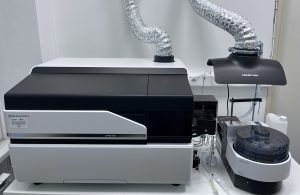
UV-VIS, UV-1900i (Shimadzu)
The UV-1900i ultraviolet spectrophotometry has dual-beam optics covering a wavelength range between 190 nm and 1100 nm with a spectral bandwidth of 1 nm and a photometric range up to 4 Abs. The noise detected at 700 nm is less than 0.00005 Abs The built-in ultra-fast scanning capability enables data acquisition at speeds up to 29 000 nm/min.
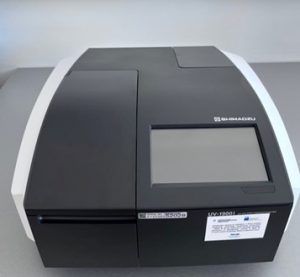
AAS, AA-7000 (Shimadzu)
Atomic absorption spectroscopy is one of the most important spectroscopic techniques for the quantitative analysis of elements. The AA-7000 is a dual-beam optical system with a wavelength range from 185 to 900 nm. The equipment also includes two methods for background correction: BGS-SR (185–900 nm) and BGS-D2 (185–430 nm). The flame technology allows microsampling from 2 to 90 µL and automatic optimization of the flame. The instrument has advanced safety features such as gas pressure monitoring, automatic fuel gas leak detection, flame monitoring, and automatic flame shutdown in case of power failure, and a vibration sensor.
The graphite furnace (GFA-7000A) is a device that provides control of temperature, gas flow, and automated optimization of parameters for each target element. This high-tech control plays a key role in all phases of analysis, including drying, ashing, and atomization. It is equipped with two separate gas inlets – for inert gas and oxidizer.
Advanced temperature control allows operation over a wide temperature range, from room temperature up to 3000 °C. At the same time, up to 20 levels of temperature programs can be set. The autosampler (ASC-7000) in AA -7000, controlled by a software, supports flame and graphite furnace (electrothermal) techniques and has a capacity of 60 samples. It has a built-in purge mechanism that prevents contamination between two samples.
